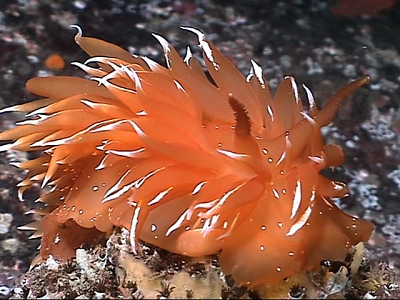
Dirona pellucida
Volodchenko, 1941
Order: NUDIBRANCHIA
Suborder: ARMININA
Family: Dironidae
DISTRIBUTION
Known from Coos Bay, Oregon at the southern end to Norton Sound, Alaska and west across the Bering Sea to Russia and the Sea of Japan. Also recorded in Forum from Sth Korea.
PHOTO
near Mayne Island, British Columbia, Canada, 20 m. Size: approx: 100 mm. Photo: Clinton Bauder.
For years, opisthobranch workers along the northeastern Pacific coast of Nth America knew this species as Dirona aurantia Hurst, 1966. Martynov (1997), showed that it was originally described from Russia, in 1941 as Dirona pellucida. The Japanese species D. akkeshiensis Baba, 1957 is also the same.
This brilliantly colored Dirona reaches 120 mm in length. Its body is bright orange to reddish-orange, with scattered white granular spots. A tapering while line extends up the margin of each ceras. It feeds on the bryozoan, Bugula pacifica. Its recorded range extends from Coos Bay, Oregon at the southern end to Norton Sound, Alaska and west across the Bering Sea to Russia and the Sea of Japan, south to Korea.
-
Baba, K. (1957) A revised list of the species of Opisthobranchia from the northern part of Japan, with some additional descriptions. Journal Faculty Science, Hokkaido Imperial University, series 6, Zoology, 13(1-4): 8-14.
-
Hurst, A (1966) A description of a new species of Dirona from the north-east Pacific. The Veliger 9(1): 9-15.
-
Volodchenko, N. I. (1941) New nudibranchiate molluscs from seas of the far-east of the U.S.S.R. Investigations of the far eastern seas of the U.S.S.R. 1:53-72, pls. 1-4. [Issledovani Dal'nevostochnykh Morei S.S.S.R.]. [In Russian ].
-
Robilliard, G.A. (1971) Range extensions of some northeast Pacific nudibranchs (Mollusca: Gastropoda:Opisthobranchia) to Washington and British Columbia, with notes on their biology. The Veliger, 14: 162-165.
-
Martynov, A. V., 1997. Opisthobranch molluscs of coastal waters of Commander Islands with notes on their fauna in the Far-East Seas of Russia. [In] Donnaya fauna i flora schelifa Komandorskikh Ostrovov. pp. 230-241. Vladivostok, DalÕnauka, ed. A.V. Rzhavsky (in Russian).
Behrens, D. W., 2006 (December 14) Dirona pellucida Volodchenko, 1941. [In] Sea Slug Forum. Australian Museum, Sydney. Available from http://www.seaslugforum.net/find/diropell
Related messages
Question about feeding in Dirona pellucida
March 17, 2008
From: Jackie Hildering
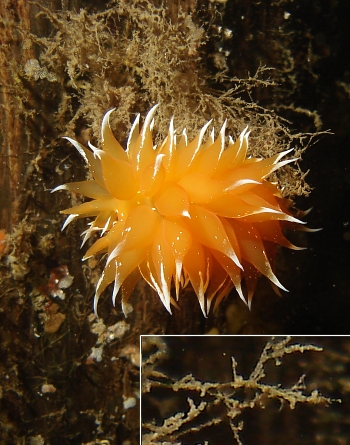
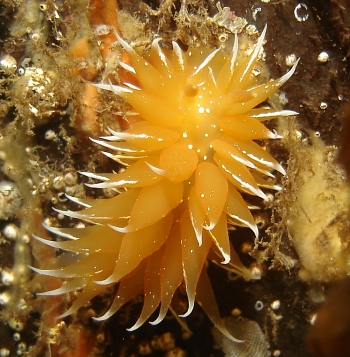
Found about 15 Dirona pellucida on the pilings at this site. Having checked the species information, I learned that they eat the bryozoan Bugula pacifica. I believe they might be targeting another bryozoan species here? I am no bryozoan expert but hope that someone might be able to offer feedback. Otherwise, the images are just a contribution to add to the behaviour of this species.
Just making sure too, despite specimens being atop sponges, I expect it is very unlikely that they would be feeding on them but rather are just travelling across them on their hunt for the bryozoans?
Locality: Telegraph Cove, 15 feet , British Columbia, Canada, Pacific Ocean, 04 November 2007, Pilings. Length: 10 cm . Photographer: Jackie Hildering.
Jackie Hildering
earthlingenterprises@telus.net
Hildering, J., 2008 (Mar 17) Question about feeding in Dirona pellucida. [Message in] Sea Slug Forum. Australian Museum, Sydney. Available from http://www.seaslugforum.net/find/21140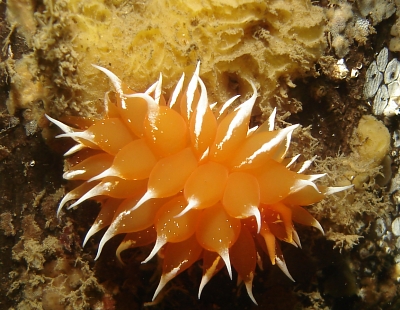
Hi Jackie,
Your observations are exactly correct. This species is a ectoproct feeder and is likely out foraging for fresh prey. I cannot tell from Bill's inset what species this might be, if it is in fact a bryozoan, and not a hydroid. In either event the tuft is pretty dead.
Comparing the radula of this species with that of a sponge eating dorid, the differences in morphology are significant. Additionally, it likely feeds on several species, but nothing has been published on this.
Thanks,
Dave Behrens
Dirona pellucida feeding
February 18, 2008
From: J. Hildering & G. Miller
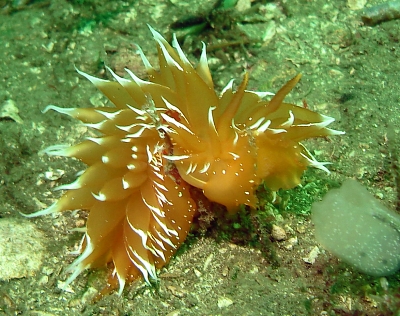
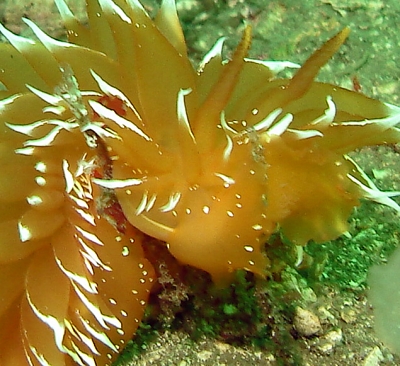
This is a follow-up to my message of November 17th [#20868 ]. This image captures a Dirona pellucida feeding on what we believe is a hydroid on the exterior of a tube worm (Spicochaetopterus costarum?). We have observed Flabellina triophina (message #12533 ) and Dirona albolineata feeding in this manner too.
Anyone know what hydroid species this may be?
Locality: Bear Cove, 40', British Columbia, Canada, Pacific Ocean, 02 December 2007, Sandy bottom. Length: 12 cm. Photographer: Jackie Hildering.
Jackie Hildering & Glen Miller
earthlingenterprises@telus.net
Hildering, J. & Miller, G., 2008 (Feb 18) Dirona pellucida feeding. [Message in] Sea Slug Forum. Australian Museum, Sydney. Available from http://www.seaslugforum.net/find/21259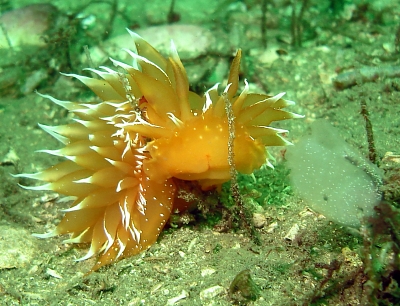
Hi Jackie and Glen,
Sorry but I can't see enough of the prey to even ID it to Phylum. It really does look like the F. triophina feeding photos. Great photo of this beautiful species however.
Thanks,
Dave Behrens
Dirona pellucida from Puget Sound
December 18, 2006
From: Mary Jo Adams
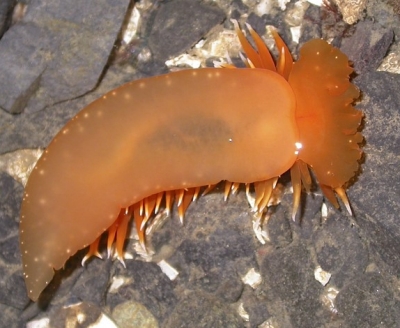
While exploring tidepools at Deception Pass State Park on Fidalgo Island, Washington (USA) we found three Dirona aurantia. One of them appeared to be hanging upside down from the surface tension of the water. We have seen this behavior before in Dirona albolineata and Triopha catalinae and wonder if anyone has an explanation for for why they do this. Also, we have not been able to find much information about Dirona aurantia. Does anyone know what they feed on?
Locality: Deception Pass State Park, low intertidal, Washington, USA, Puget Sound area, 05 December 2006, rocky intertidal. Length: 1 1/2 inches/ 4 cm. Photographer: Jan Holmes and Mary Jo Adams.
Thank you!
Mary Jo
mjadams52@comcast.net
Adams, M. J., 2006 (Dec 18) Dirona pellucida from Puget Sound. [Message in] Sea Slug Forum. Australian Museum, Sydney. Available from http://www.seaslugforum.net/find/18967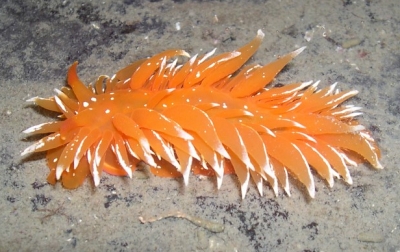
Hi Mary Jo,
Thanks for sharing this observation. Many species venture out onto the surface of tidepools when the tide is out and the pools are very calm. They are likely just cruising around looking for food. Because they have almost neutral bouyancy (no shell to drag them to the bottom), they can easily hang by surface tension.
The name Dirona aurantia, has been suppressed as a synonym to an earlier description of this species from Russia. The current correct name is Dirona pellucida. [see new Fact Sheet].
Although not seen in your photos, this species feeds on the branching bryozoan, Bugula pacifica.
Best wishes,
Dave Behrens
Dirona pellucida from South Korea
December 18, 2006
From: Dong Bum Koh
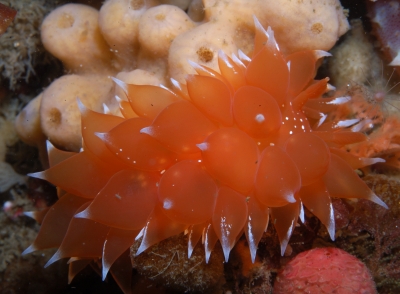
Dear Bill,
Concerning a photo in my book Sea Slugs of Korea. This is a photo of what I think is a pink colored Dirona aurantia from South Korea. Is this different from D. pellucida?
Locality: Gang Reung , 15 m, Gwang Won Prov. Korea, East Sea, .[E 129°N 38°8'] 04 June 2006. Length: Approx. 35 mm. Photographer: Tae Ho Cho.
Best regards,
Dong Bum Koh
drkoh@seasee.co.kr
Koh, D. B., 2006 (Dec 18) Dirona pellucida from South Korea. [Message in] Sea Slug Forum. Australian Museum, Sydney. Available from http://www.seaslugforum.net/find/17081Dear Koh,
They are on fact the same species. I'm afraid I have been a bit slow in making the change on the Forum. Martynov (1997), showed that Dirona aurantia from the Pacific coast of Nth America had already been described from Russia, in 1941, as Dirona pellucida. It also been described from nthn Japan as D. akkeshiensis Baba, 1957. Dave Behrens has just prepared a Fact Sheet for the species.
Best wishes,
Bill Rudman
Re: Dirona aurantia from South Korea
July 4, 2005
From: Marli Wakeling
Note added December 2006: This species is now known as Dirona pellucida Volodchenko, 1941.
Concerning Koh's animal [message #14155]:
The white markings seem to suggest Dirona aurantia, as D. albolineata has lines over the cerata, rather than white tips. The spots also suggest D. aurantia. The colour, however, of every specimen I've ever seen has been very bright orange. There is large variation in D. albolineata here: from translucent white through orange, pink and mauve. D. aurantia is seen here (British Columbia) as a winter species, December through April. D. albolineata is seen year round.
Interesting find!
Marli Wakeling
scubamarli@gmail.com
Wakeling, M., 2005 (Jul 4) Re: Dirona aurantia from South Korea. [Message in] Sea Slug Forum. Australian Museum, Sydney. Available from http://www.seaslugforum.net/find/14184Dirona aurantia from South Korea
July 2, 2005
From: Dong Bum Koh
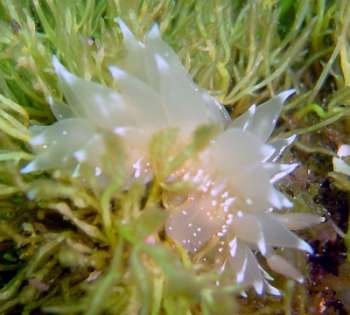
Note added December 2006: This species is now known as Dirona pellucida Volodchenko, 1941.
Dear Bill,
This is a photo of what I think is Dirona aurantia from South Korea. We are not sure however whether this animal is Dirona aurantia or D. albolineata. Could you make a decision for us?
Locality: Sa Cheon Beach. Kwang Won Prov., South Korea. Depth: 10 m. Length: From 35mm - 70mm. 26 June. 2005. Photographer: Im Sung Hwang
Best regards,
Dong Bum Koh
drkoh@seasee.co.kr
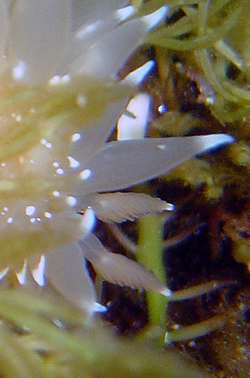
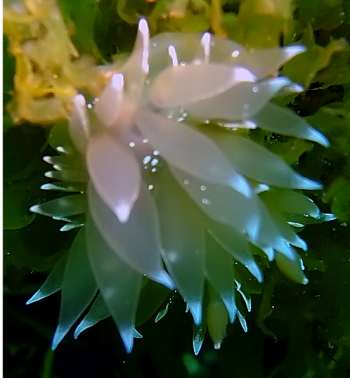
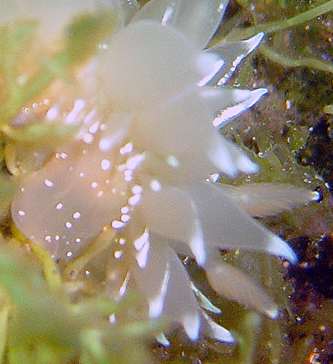
Dear Koh,
I am not an expert on Dirona but I think you are right in thinking this is a pale D. aurantia. One of the characteristics of D. albolineata is a white line, as its name suggests around the edge of the foot and head. The only bit of the foot I can see is in the photo alongside, and there is no sign of a white line present.
I note that D. albolineata and D. picta have been reported from the NW Pacific, so your find may be a new geographic record for the species previously known only from the NE Pacific. I will be intersted in comments from our colleagues on the Nth Americam west coast who are more familar with this group.
Best wishes,
Bill Rudman
Dirona aurantia from British Columbia
October 23, 2003
From: Bruce Wight
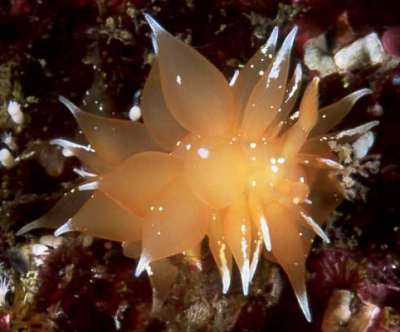
Note added December 2006: This species is now known as Dirona pellucida Volodchenko, 1941.
Dear Bill,
Johanna and I were up at the Northern end of Vancouver Island the first week of October diving around Port Hardy and Browning Pass. This was our first time diving in Canada. The water was 48 degrees F and the visibility was averaging around 60 feet. Many new nudibranchs for us, two species of Dirona, two species of Acanthodoris, Tochuina tetraquetra, and Flabellina verrucosa. I am sending some of the images of the nudibranchs from the trip hope you enjoy them. This one is ofDirona aurantia.
If you ever go up to the Vancouver area, try the Nautilus Explorer it is a great boat and you get plenty of diving in.
Take care,
Bruce Wight
bwproductions@earthlink.net
Wight, B., 2003 (Oct 23) Dirona aurantia from British Columbia. [Message in] Sea Slug Forum. Australian Museum, Sydney. Available from http://www.seaslugforum.net/find/11279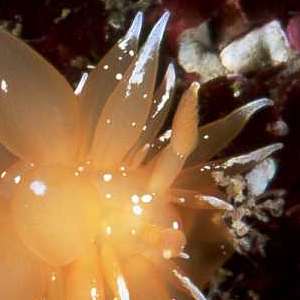
Thanks Bruce,
I have split your photos up into separate messages. It was certainly a productive trip
Best wishes
Bill Rudman
Dirona aurantia from British Columbia
January 14, 2003
From: Clinton Bauder
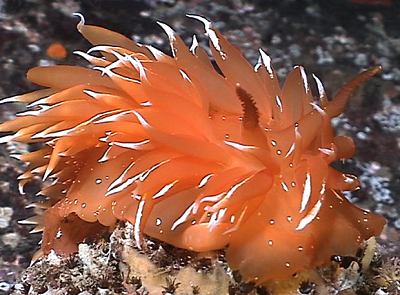
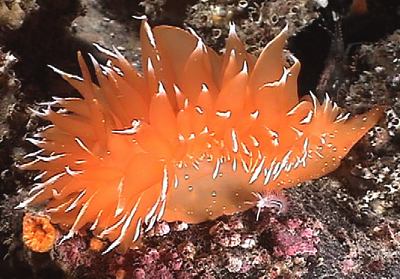
Note added December 2006: This species is now known as Dirona pellucida Volodchenko, 1941.
Hi Bill,
This isDirona aurantia. It was seen on a night dive near Mayne Island, British Columbia, Canada in about 20 m of water. Size was maybe 100 mm.
Clinton
gecko1@apple.com
Bauder, C., 2003 (Jan 14) Dirona aurantia from British Columbia. [Message in] Sea Slug Forum. Australian Museum, Sydney. Available from http://www.seaslugforum.net/find/8857Thanks Clintom,
Bill Rudman
Dirona aurantia from British Columbia
June 5, 2000
From: Marli Wakeling
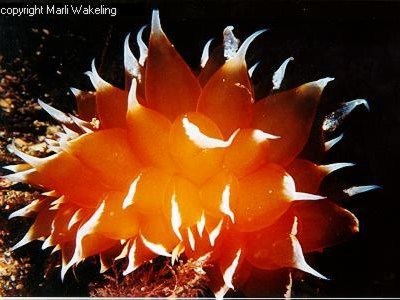
Note added December 2006: This species is now known as Dirona pellucida Volodchenko, 1941.
Hi Bill,
Here is a photo ofDirona aurantia. This beautiful animal is prevalent in the spring in British Columbia [Canada]. Reaching lengths of 10 cm., it reacts to divers by swelling its cerata. There is another nudibranch that mimics this one, but it is new and undescribed; in fact it is a Janolus sp. One can tell the difference from the liver coloured digestive tract...otherwise identical. I have not seen one, but they have been found in Alaska and on the Sechelt Penninsula, B.C.
Marli Wakeling
scubamarli@excite.com
Wakeling, M., 2000 (Jun 5) Dirona aurantia from British Columbia. [Message in] Sea Slug Forum. Australian Museum, Sydney. Available from http://www.seaslugforum.net/find/2500Dear Marli,
This is indeed a beautiful animal. Have you any idea what this species feeds on? Anne Hurst in her description of this species says that it contained hydroids, bryozoans and crustaceans in its gut and in aquaria lived quite well as a scavenger. She obviously didn't have the benefit of observing the animals in their natural environment so any information on where you find them would be of interest. I also note that another species from your part of the world, Dirona albolineata was reported to feed on a number of species of snails (Robilliard, 1971).
Best wishes,
Bill Rudman.
References:
• Hurst, A (1966) A description of a new species of Dirona from the north-east Pacific. The Veliger 9(1): 9-15.
• Robilliard, G.A. Predation by the nudibranch Dirona albolineata on three species of Prosobranchs. Pacific Science, 25(3): 429-435.
